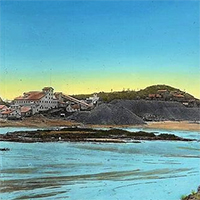Assessing the potential environmental factors affecting cladoceran assemblage composition in arsenic-contaminated lakes near abandoned silver mines

Submitted: 19 January 2021
Accepted: 17 April 2021
Published: 17 May 2021
Accepted: 17 April 2021
Abstract Views: 756
PDF: 298
Supplementary: 77
HTML: 11
Supplementary: 77
HTML: 11
Publisher's note
All claims expressed in this article are solely those of the authors and do not necessarily represent those of their affiliated organizations, or those of the publisher, the editors and the reviewers. Any product that may be evaluated in this article or claim that may be made by its manufacturer is not guaranteed or endorsed by the publisher.
All claims expressed in this article are solely those of the authors and do not necessarily represent those of their affiliated organizations, or those of the publisher, the editors and the reviewers. Any product that may be evaluated in this article or claim that may be made by its manufacturer is not guaranteed or endorsed by the publisher.
Similar Articles
- Shuchun Yao, Bin Xue, Sediment records of the metal pollution at Chihu Lake near a copper mine at the middle Yangtze River in China , Journal of Limnology: Vol. 75 No. 1 (2016)
- Martha Patricia Celis-Salgado, Wendel (Bill) Keller, Norman D. Yan, Calcium and sodium as regulators of the recovery of four Daphnia species along a gradient of metal and base cations in metal contaminated lakes in Sudbury, Ontario, Canada , Journal of Limnology: Vol. 75 No. s2 (2016): Lake Orta: a new lease on life
- Arpana Yadav, Lalit Kumar Pandey, In situ effects of arsenic, aluminium and chromium stresses on algal periphyton of the river Ganga at Varanasi, India , Journal of Limnology: Vol. 82 (2023)
- Ruben Ladrera, Miguel Cañedo-Argüelles, Narcís Prat, Impact of potash mining in streams: the Llobregat basin (northeast Spain) as a case study , Journal of Limnology: Vol. 76 No. 2 (2017)
- Roberta Piscia, Simone Tabozzi, Roberta Bettinetti, Liisa Nevalainen, Marina M. Manca, Unexpected increases in rotifer resting egg abundances during the period of contamination of Lake Orta , Journal of Limnology: Vol. 75 No. s2 (2016): Lake Orta: a new lease on life
- Javier Sánchez-Hernández, Fernando Cobo, Ontogenetic shifts in terrestrial reliance of stream-dwelling brown trout , Journal of Limnology: Vol. 75 No. 2 (2016)
- Andrea Di Cesare, Ester Eckert, Gianluca Corno, Co-selection of antibiotic and heavy metal resistance in freshwater bacteria , Journal of Limnology: Vol. 75 No. s2 (2016): Lake Orta: a new lease on life
- Norman D. Yan, John Bailey, James C. McGeer, Marina M. Manca, Wendel (Bill) Keller, Martha P. Celis-Salgado, John M. Gunn, Arrive, survive and thrive: essential stages in the re-colonization and recovery of zooplankton in urban lakes in Sudbury, Canada , Journal of Limnology: Vol. 75 No. s2 (2016): Lake Orta: a new lease on life
- Paraskeva Michailova, Julia Ilkova, Ewa Szarek-Gwiazda, Andrzej Kownacki, Dariusz Ciszewski, Genome instability in Chironomus annularius sensu Strenzke (Diptera, Chironomidae): A biomarker for assessment of the heavy metal contaminants in Poland , Journal of Limnology: Vol. 77 No. s1 (2018): Recent advances in the study of Chironomidae: An overview
- Xu Sun, Zhixin Hu, Wen Jia, Cuilan Duan, Liuyan Yang, Decaying cyanobacteria decrease N2O emissions related to diversity of intestinal denitrifiers of Chironomus plumosus , Journal of Limnology: Vol. 74 No. 2 (2015)
You may also start an advanced similarity search for this article.

 https://doi.org/10.4081/jlimnol.2021.2004
https://doi.org/10.4081/jlimnol.2021.2004





